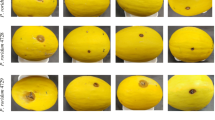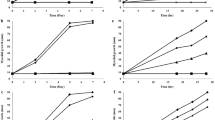Abstract
This study evaluated the efficacy of the combined application of chitosan (CS) and Zataria multiflora (ZEO) or Cinnamomum zeylanicum essential oils (CEO) on the inhibition of Botrytis cinerea, the causal agent of strawberry gray mold on laboratory media and fruits during storage (7 days at 4 °C followed by 3 days at 20 °C). The application of different CS, CEO and ZEO concentrations inhibited the mycelial growth of the assayed fungus. The mixtures of CS and CEO (CC) or ZEO (CZ) inhibited the mycelia growth in potato dextrose agar, as well as the growth of B. cinerea in artificially infected strawberries stored at both room and cold temperature. Moreover, combined treatments showed more significant mycelial inhibition results and reduction of the IC50, MIC and MFC values compared to pure EOs or CS (p < 0.05). In fruit decay assays, combined treatments (CC or CZ) were able to reduce fungal decay in the range of 60–85 % at 9th day of storage. These results demonstrate the potential of the combined application of CS and CEO or ZEO at sub-inhibitory concentrations to control post-harvest pathogenic fungi in fruits, in particular, B. cinerea in strawberries.



Similar content being viewed by others
References
Abdolahi A, Hassani A, Ghosta Y, Bernousi I, Meshkatalsadat M (2010) Study on the potential use of essential oils for decay control and quality preservation of Tabarzeh table grape. J Plant Protect Res 50(1):45–52
Aider M (2010) Chitosan application for active bio-based films production and potential in the food industry: review. LWT-Food Sci Technol 43(6):837–842
Amil-Ruiz F, Blanco-Portales R, Muñoz-Blanco J, Caballero JL (2011) The strawberry plant defense mechanism: a molecular review. Plant Cell Physiol 52(11):1873–1903
Askarne L, Talibi I, Boubaker H, Boudyach E, Msanda F, Saadi B, Ait Ben Aoumar A (2012) In vitro and in vivo antifungal activity of several Moroccan plants against Penicillium italicum, the causal agent of citrus blue mold. Crop Prot 40:53–58
Avila-Sosa R, Palou E, Jiménez Munguía MT, Nevárez-Moorillón GV, Navarro Cruz AR, López-Malo A (2012) Antifungal activity by vapor contact of essential oils added to amaranth, chitosan, or starch edible films. Int J Food Microbiol 153(1):66–72
Badawy ME, Rabea EI (2009) Potential of the biopolymer chitosan with different molecular weights to control postharvest gray mold of tomato fruit. Postharvest Biol Technol 51(1):110–117
Bakkali F, Averbeck S, Averbeck D, Idaomar M (2008) Biological effects of essential oils—a review. Food Chem Toxicol 46(2):446–475
Bassolé IHN, Juliani HR (2012) Essential oils in combination and their antimicrobial properties. Molecules 17(4):3989–4006
Bennis S, Chami F, Chami N, Bouchikhi T, Remmal A (2004) Surface alteration of Saccharomyces cerevisiae induced by thymol and eugenol. Lett Appl Microbiol 38(6):454–458
Bouchra C, Achouri M, Idrissi Hassani L, Hmamouchi M (2003) Chemical composition and antifungal activity of essential oils of seven Moroccan Labiatae against Botrytis cinerea Pers: Fr. J Ethnopharmacol 89(1):165–169
Burt S (2004) Essential oils: their antibacterial properties and potential applications in foods—a review. Int J Food Microbiol 94(3):223–253
Carmo ES, Lima EDO, Souza ELD, Sousa FBD (2008) Effect of cinnamomum zeylanicum blume essential oil on the rowth and morphogenesis of some potentially pathogenic Aspergillus species. Braz J Microbiol 39(1):91–97
Cháfer M, Sánchez‐González L, González‐Martínez C, Chiralt A (2012) Fungal decay and shelf life of oranges coated with chitosan and bergamot, thyme, and tea tree essential oils. J Food Sci 77(8):E182–E187
dos Santos NST, Athayde Aguiar AJA, de Oliveira CEV, Veríssimo de Sales C, de Melo e Silva S, Sousa da Silva R, de Souza EL (2012) Efficacy of the application of a coating composed of chitosan and Origanum vulgare L. essential oil to control Rhizopus stolonifer and Aspergillus niger in grapes (Vitis labrusca L.). Food Microbiol 32(2):345–353
Dutta J, Tripathi S, Dutta P (2012) Progress in antimicrobial activities of chitin, chitosan and its oligosaccharides: a systematic study needs for food applications. Food Sci Technol Int 18(1):3–34
Gatto MA, Ippolito A, Linsalata V, Cascarano NA, Nigro F, Vanadia S, Di Venere D (2011) Activity of extracts from wild edible herbs against postharvest fungal diseases of fruit and vegetables. Postharvest Biol Technol 61(1):72–82
Ghorbani F, Panjehkeh N, Nasrollanejad S, Salari M, Sabagh S (2014) Inhibitory effect of essential oils of Eucalyptus sp. and Zataria multiflora on fungal growth of Macrophomina phaseolina. Archives of Phytopathology and Plant Protection (ahead-of-print), 1–4
Guo Z, Xing R, Liu S, Zhong Z, Ji X, Wang L, Li P (2008) The influence of molecular weight of quaternized chitosan on antifungal activity. Carbohydr Polym 71(4):694–697
Hassani A, Fathi Z, Ghosta Y, Abdollahi A, Meshkatalsadat MH, Marandi RJ (2012) Evaluation of plant essential oils for control of postharvest brown and gray mold rots on apricot. J Food Saf 32(1):94–101
Hernández-Lauzardo A, Bautista-Baños S, Velázquez-del Valle M, Méndez-Montealvo M, Sánchez-Rivera M, Bello-Pérez L (2008) Antifungal effects of chitosan with different molecular weights on in vitro development of Rhizopus stolonifer(Ehrenb.: Fr.) Vuill. Carbohydr Polym 73(4):541–547
Hu Y, Du Y-M, Liu H (2003) Antimicrobial activity of chitosan in combination with thymol. J-Wuhan Univ Nat Sci Ed 49(2):261–265
Jianglian D, Shaoying Z (2013) Application of Chitosan Based Coating in Fruit and Vegetable Preservation. J Food Process Technol 4(5)
Matan N, Rimkeeree H, Mawson A, Chompreeda P, Haruthaithanasan V, Parker M (2006) Antimicrobial activity of cinnamon and clove oils under modified atmosphere conditions. Int J Food Microbiol 107(2):180–185
Mohamed NH, El-Hadidy AM (2008) Studies of biologically active constituents of Verbascum eremobium Murb. and its inducing resistance against some diseases of cucumber. Egypt J Phytopathol 36:133–150
Moradi M, Tajik H, Razavi Rohani SM, Oromiehie AR (2011) Effectiveness of Zataria multiflora Boiss essential oil and grape seed extract impregnated chitosan film on ready‐to‐eat mortadella‐type sausages during refrigerated storage. J Sci Food Agric 91(15):2850–2857
Paster N, Bullerman LB (1988) Mould spoilage and mycotoxin formation in grains as controlled by physical means. Int J Food Microbiol 7(3):257–265
Perdones A, Sánchez-González L, Chiralt A, Vargas M (2012) Effect of chitosan–lemon essential oil coatings on storage-keeping quality of strawberry. Postharvest Biol Technol 70:32–41
Powelson R (1960) Initiation of strawberry fruit rot caused by Botrytis cinérea. Phytopathology 50:491–494
Romanazzi G, Nigro F, Ippolito A (2000) Effectiveness of pre and postharvest chitosan treatments on storage decay of strawberries. Rivista di Frutticoltura e di Ortofloricoltura 62(5):71–75
Saei-Dehkordi SS, Tajik H, Moradi M, Khalighi-Sigaroodi F (2010) Chemical composition of essential oils in Zataria multiflora Boiss. from different parts of Iran and their radical scavenging and antimicrobial activity. Food Chem Toxicol 48(6):1562–1567
Sajed H, Sahebkar A, Iranshahi M (2013) Zataria multiflora Boiss. (Shirazi thyme)—an ancient condiment with modern pharmaceutical uses. J Ethnopharmacol 145(3):686–698
Sánchez-González L, Pastor C, Vargas M, Chiralt A, González-Martínez C, Cháfer M (2011) Effect of hydroxypropylmethylcellulose and chitosan coatings with and without bergamot essential oil on quality and safety of cold-stored grapes. Postharvest Biol Technol 60(1):57–63
Sellamuthu PS, Sivakumar D, Soundy P, Korsten L (2013) Essential oil vapours suppress the development of anthracnose and enhance defence related and antioxidant enzyme activities in avocado fruit. Postharvest Biol Technol 81:66–72
Shao X, Cao B, Xu F, Xie S, Yu D, Wang H (2015) Effect of postharvest application of chitosan combined with clove oil against citrus green mold. Postharvest Biol Technol 99:37–43
Shao X, Wang H, Xu F, Cheng S (2013) Effects and possible mechanisms of tea tree oil vapor treatment on the main disease in postharvest strawberry fruit. Postharvest Biol Technol 77:94–101
Soylu EM, Kurt Ş, Soylu S (2010) In vitro and in vivo antifungal activities of the essential oils of various plants against tomato grey mould disease agent Botrytis cinerea. Int J Food Microbiol 143(3):183–189
Tikhonov VE, Stepnova EA, Babak VG, Yamskov IA, Palma-Guerrero J, Jansson H-B, Avdienko ID (2006) Bactericidal and antifungal activities of a low molecular weight chitosan and its N-/2 (3)-(dodec-2-enyl) succinoyl/-derivatives. Carbohydr Polym 64(1):66–72
Tripathi P, Dubey N (2004) Exploitation of natural products as an alternative strategy to control postharvest fungal rotting of fruit and vegetables. Postharvest Biol Technol 32(3):235–245
Vu K, Hollingsworth R, Leroux E, Salmieri S, Lacroix M (2011) Development of edible bioactive coating based on modified chitosan for increasing the shelf life of strawberries. Food Res Int 44(1):198–203
Wang L, Liu F, Jiang Y, Chai Z, Li P, Cheng Y, Leng X (2011) Synergistic antimicrobial activities of natural essential oils with chitosan films. J Agric Food Chem 59(23):12411–12419
Xing Y, Li X, Xu Q, Yun J, Lu Y, Tang Y (2011) Effects of chitosan coating enriched with cinnamon oil on qualitative properties of sweet pepper (Capsicum annuum L.). Food Chem 124(4):1443–1450
Yen T-B, Chang S-T (2008) Synergistic effects of cinnamaldehyde in combination with eugenol against wood decay fungi. Bioresour Technol 99(1):232–236
Author information
Authors and Affiliations
Corresponding authors
Rights and permissions
About this article
Cite this article
Mohammadi, A., Hashemi, M. & Hosseini, S. The control of Botrytis fruit rot in strawberry using combined treatments of Chitosan with Zataria multiflora or Cinnamomum zeylanicum essential oil. J Food Sci Technol 52, 7441–7448 (2015). https://doi.org/10.1007/s13197-015-1871-7
Revised:
Accepted:
Published:
Issue Date:
DOI: https://doi.org/10.1007/s13197-015-1871-7




